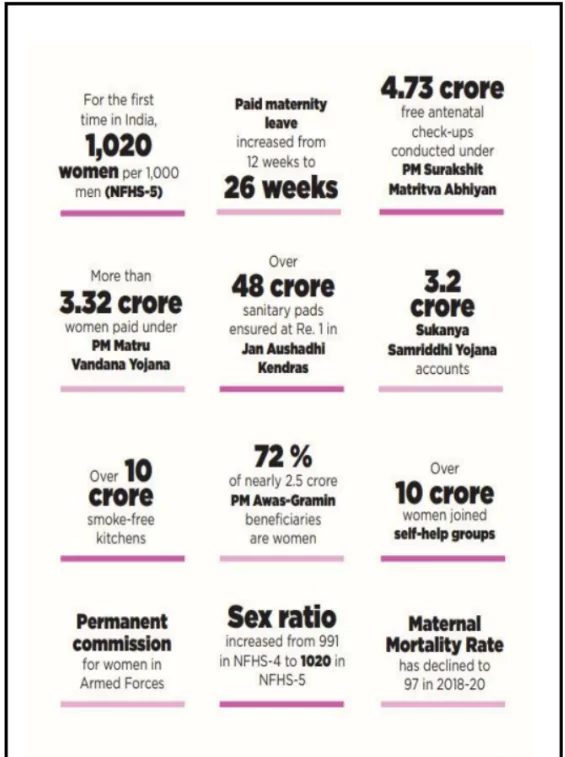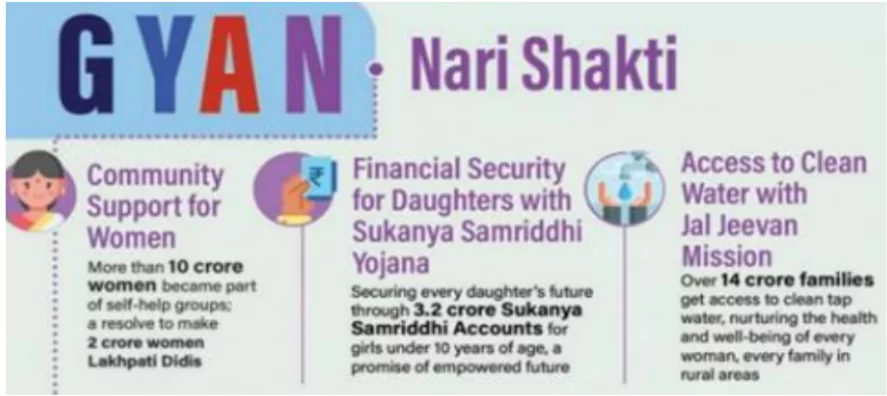Recently, the Prime Minister declared women-led development as the cornerstone of governance at Ahilya Bai’s 300th birth anniversary event in Bhopal, Madhya Pradesh.
- The Prime Minister also highlighted that the Government follows Lokmata Ahilyabai Holkar’s mantra of “Nagarik Devo Bhava” (Citizen as God).
About Women Led Development
- Women-Led Development is a development approach where women lead, shape, and drive economic, social, and political progress, rather than being passive beneficiaries.
- It emphasizes women’s leadership, agency, and active participation in decision-making, policy formulation, and implementation.
- A paradigm shift from women’s development (services to women) to women-led development (women as leaders and innovators).
About Ahilyabai
- She was the Queen (Maharani) of the Holkar dynasty in the Maratha-ruled Malwa region, India.
- Born in Chandi, Maharashtra, to Mankoji Shinde and Sushila Shinde.
- Belonged to a Marathi Hindu Dhangar family.
- Ahilyabai’s Education and Military Training
- Involved in administration, finances, and diplomacy under Malhar Rao’s guidance.
- Trained in politics and governance by her mother-in-law, Gautama Bai Holkar.
- In 1765, led a successful military attack on Gwalior, following her father-in-law’s instructions.
Ahilyabai’s Reign and contributions
- Established Maheshwar (Madhya Pradesh) as the seat of the Holkar Dynasty.
- Established the textile industry in Maheshwar: The Maheshwari sarees, still popular today, were promoted under her reign.
- It features a special double-sided border woven using the ‘bugdi’ two-way technique.
- Renovation of Kashi Vishwanath Temple in Varanasi in 1780.
|
Need for Women Led Development
- Accelerating Economic Growth: India’s GDP can increase by up to 30% by bridging the gender gap in workforce participation (NFHS data).
- Indian women, despite constituting 48% of the population, contribute only 18% to the gross domestic product (GDP), found a study by the National Family Health Survey.
- Addressing Widening Gender Inequality: India ranks 129/146 in Global Gender Gap Report, 2024, with declines in education and economic participation.
- India’s female labour force participation rate (FLFPR) has seen a rise, jumping from 23.3% in 2017-18 to 41.7% in 2023-24, but below global average (48.7%)
- Promoting Inclusive and Sustainable Development: Women play a critical role in climate resilience, food security, and community welfare.
 Women-led grassroots initiatives like the Deendayal Antyodaya Yojana-NRLM mobilized over 10 crore women in self-help groups improving livelihoods.
Women-led grassroots initiatives like the Deendayal Antyodaya Yojana-NRLM mobilized over 10 crore women in self-help groups improving livelihoods.
- Enhancing Healthcare and Social Well-being: Women-led development improves health outcomes and reduces maternal mortality.
- Extended maternity leave from 12 to 26 weeks ensures better maternal and child health.
- Empowering Women Financially and Legally: Women owning property and having access to financial resources promotes dignity and decision-making power.
- While 73.2% of rural women work in agriculture, they only own about 12.8% of landholdings.
- Fostering Political Participation and Governance: Increased representation of women in governance leads to gender-sensitive policies and social inclusion.
- In India, women representation in the parliament is only 14.7%, compared to the global average of 26.5% (UN Women, 2024).
- Creating Social and Cultural Transformation: Women-led development challenges traditional gender roles and promotes equality.
- Women-led start-ups and increasing participation in (STEM) Science, technology, engineering, and mathematics (43% female STEM graduates) shift societal mindsets towards recognizing women’s capabilities.
Current Status of Women in India
- Workforce Participation
- FLFPR: Increased from 23.3% (2017-18) to 41.7% (2023-24), with rural FLFPR at 47.6% (Economic Survey 2024-25).
- Gender Pay Gap: Women earn 20-36.7% less than men (WEF, 2023; Global Gender Gap Report).
- Unpaid Care Work: Women spend 5x more time than men on unpaid domestic work (Time Use Survey, 2020).
- Sectoral Distribution: 76.2% rural women in agriculture, 40.1% urban women in services (2023-24).
- Education
- Female Literacy: 71.5% (NFHS-5, 2023), compared to 87.4% for men; the global average is 79.9%.
- STEM: 43% of STEM graduates are women (highest globally), but only 14% participate in the STEM workforce.
- Health
- Maternal Mortality Rate: 97 per 1 lakh live births (2018-20), a significant improvement.
- Anemia: 57% of women aged 15-49 are anemic (NFHS-5, 2021).
- Domestic Violence: 29.3% of married women face domestic violence (NFHS-5, 2021).
- Entrepreneurship & Financial Inclusion
- Startups: 73,151 startups (50% of total) have at least one woman director; 7,000 are women-led (7.5% of total).
- Enterprises: 20% of non-farm enterprises are women-owned, 80% informal (MSME Report 2023-24). Only 13.76% of entrepreneurs are women.
- Women operate nearly 55% of bank accounts opened under PM Jan Dhan Yojana.
- Leadership
- Defense: Women in combat roles and NDA; Avani Chaturvedi became the first female fighter pilot (2016). Operation Sindoor (2025) led by women like Col. Sophia Qureshi symbolizes “woman power.”
- Police: States reserve 10-35% police positions for women.
- Judiciary: 14% of High Court judges are women; Justice B.V. Nagarathna is set to be India’s first woman CJI (2027).
- Digital Inclusion
- Mobile Ownership: 25% of women vs. 41% of men own mobile phones (GSMA, 2024).
- Internet Access: The Mobile Gender Gap Report 2021 highlights that Indian women are 15% less likely to use mobile internet than men.
Government Policies and Initiatives for Women-Led Development in India
- Legislative Measures
- Nari Shakti Vandan Adhiniyam (Women’s Reservation Bill), 2023: Reserves one-third of seats for women in Lok Sabha, State Legislative Assemblies, and Delhi Assembly.
- First major legislation passed in the new Parliament building, symbolizing the focus on women’s leadership.
- Muslim Women (Protection of Rights on Marriage) Act, 2019: Abolished instant triple talaq, providing legal protection and social justice for Muslim women.
- Extension of Maternity Leave: Maternity leave increased from 12 to 26 weeks to support working mothers.
- Education & Health Schemes
 Beti Bachao Beti Padhao (BBBP): Campaign to improve child sex ratio and promote girl child education.
Beti Bachao Beti Padhao (BBBP): Campaign to improve child sex ratio and promote girl child education.
- Resulted in sex ratio improvement from 918 (2014-15) to 937 (2020-21) and increased secondary education enrolment for girls.
- POSHAN Abhiyaan: Focused on eradicating malnutrition through real-time monitoring and engagement of over 14 lakh Anganwadis.
- Benefits around 10 crore women and children.
- Ayushman Bharat: Provides free medical treatment up to ₹5 lakh, reducing financial barriers to healthcare, especially for women.
- Science & Technology
- Schemes like Vigyan Jyoti encourage girls to pursue STEM careers through scholarships and mentorship.
- Women Scientists Scheme (WOS) supports women returning to research after career breaks.
- Programs such as KIRAN (Knowledge Involvement in Research Advancement through Nurturing) provide funding and research support exclusively to women scientists.
- Chandrayaan-3: Over 100 women scientists/engineers contributed.
- Economic Empowerment and Livelihood Programs
- Pradhan Mantri Awas Yojana – Gramin (PMAY-G): Over 72% of houses under PMAY-G owned or co-owned by women, empowering them with property rights.
- Pradhan Mantri Ujjwala Yojana (PMUY): Distributed over 10 crore LPG connections, reducing indoor air pollution and improving women’s health.
- Swachh Bharat Mission (SBM): Achieved Open Defecation Free (ODF) status, enhancing women’s sanitation, safety, and dignity.
- Jal Jeevan Mission: Ensures access to clean tap water in rural households, alleviating women’s burden of water collection.
- PM Mudra Yojana & Stand-Up India: PM Mudra Yojana sanctions 69% of 30 crore loans to women; Stand-Up India provides 84% loans to women for greenfield projects.
- Mahila Samman Savings Certificate: A dedicated savings scheme for women introduced in the 2023-24 budget to promote financial inclusion.
- Safety and Social Security
- Mission Shakti: Provides skill development, financial literacy, and access to legal and social support through One-Stop Centres and helpline (181).
- Women’s Helpline and SHe-Box: Platforms offering support to women facing violence or distress.
- Skill Development and Capacity Building
- Pradhan Mantri Kaushal Vikas Yojana (PMKVY): Increased women’s participation in skill training from 42.7% (2016) to 52.3% (2024).
- National Rural Livelihoods Mission (NRLM) / Deendayal Antyodaya Yojana: Mobilized over 10 crore women into 92 lakh Self-Help Groups (SHGs), promoting financial inclusion and entrepreneurship.
- Namo Drone Didi Campaign: Empowers women in agriculture through drone technology.
- Enhances income and morale of women.
- Support for Women Entrepreneurs and Startups
- Startup India Initiative: Recognized over 73,000 startups with at least one woman director.
- Startup India Seed Fund Scheme (SISFS) and Credit Guarantee Scheme for Startups (CGSS) provide financial support to women-led startups.
- Stand-Up India: Facilitates bank loans from ₹10 lakh to ₹1 crore to women entrepreneurs from SC/ST communities.
- Digital Literacy and Technology Access
- Digital inclusion schemes like National Digital Literacy Mission (NDLM) target rural and urban women to enhance digital skills, crucial for technology-driven sectors.
- Training of women Self-Help Groups (SHGs) to operate agricultural drones underlines women’s increasing role in tech-enabled rural development.
Challenges in Women-Led Development
- Deep-Rooted Patriarchy and Social Norms: Traditional gender roles restrict women’s autonomy and participation in leadership.
- Only 3% of women make independent household decisions (NFHS-5).
- Societal expectations around caregiving and domestic responsibilities hinder their participation in decision-making processes.
- Low Female Labour Force Participation: India’s FLFPR remains low despite recent improvement.
- Share of women in regular wage work declined from 21.9% (2018-19) to 15.9% (2022-23).
- Limited Access to Education and Skill Development: Education gaps and early marriage limit women’s empowerment and career growth.
- Female literacy rate is at 65%, lower than male literacy (82%).
- Despite 43% STEM graduates being women, a ‘leaky pipeline’ exists preventing many women from reaching senior roles.
- Gender-Based Violence and Safety Issues: Fear of violence restricts women’s mobility and participation in public life and workforce.
- India recorded over 4 lakh crimes against women in 2021 (NCRB).
- Economic Disparities and Financial Exclusion: Women face wage gaps, job insecurity, and lack of collateral, limiting access to credit.
- Only 19% of C-suite roles in India are held by women; startups also show fewer women in senior roles.
- Underrepresentation in Political and Leadership Roles: Political participation remains low despite reservations in local governance.
- Women constitute only 13.6% of Lok Sabha members and 13% of Rajya Sabha members.
- Digital Gender Divide and Technology Access: Limited digital literacy restricts women’s access to education, financial services, and markets.
- Only 25% of women own mobile phones compared to 41% of men (GSMA, 2024).
Global Efforts to Promote Women-Led Development
- Convention on the Elimination of All Forms of Discrimination against Women (CEDAW): Adopted in 1979,
- It was established through the efforts of the United Nations Commission on the Status of Women(1946) to oversee women’s rights and monitor their status worldwide.
- UN Women: formed in 2010 by the United Nations General Assembly,
- It serves as the global entity dedicated to advancing gender equality and empowering women across nations.
- International Women’s Day: Observed annually on March 8th.
- It celebrates the accomplishments of women from diverse national, cultural, linguistic, economic, and political backgrounds worldwide.
- Theme 2025: “For ALL Women and Girls: Rights. Equality. Empowerment.”
|
Way Forward for Women-Led Development
- Enhance Access to Quality Education and Skill Development: Improve girls’ access to secondary and higher education, especially in rural areas.
- Promote STEM education and digital literacy to bridge the gender gap in technology and innovation.
- Promote Women’s Economic Empowerment and Entrepreneurship: Strengthen financial inclusion by expanding credit facilities (Mudra Yojana, Stand-Up India) and easing collateral requirements.
- Support women-led startups with mentorship, incubation, and easier regulatory compliance.
- Foster women’s participation in formal sectors by recognizing and valuing unpaid care work.
- Increase Political Participation and Leadership: Expedite implementation of the Women’s Reservation Bill for greater representation in legislatures.
- Encourage women’s leadership at grassroots through capacity building of Panchayati Raj Institutions.
- Improve Healthcare and Social Protection: Expand maternal and reproductive health services, supported by schemes like Ayushman Bharat and POSHAN Abhiyaan.
- Strengthen safety nets and social protection, including better maternity benefits and protection against gender-based violence.
- Address Gender-Based Violence and Safety Concerns: Strengthen enforcement of laws and fast-track courts for crimes against women.
- Expand public safety measures like women-only transport, improved street lighting, and police patrolling.
- Bridge the Digital Gender Divide: Increase access to affordable smartphones and internet connectivity for women, especially in rural areas.
- Implement gender-responsive policies for AI and emerging technologies to avoid bias.
- Transform Social Norms and Promote Gender Sensitization: Conduct nationwide campaigns to challenge patriarchal mindsets and promote shared domestic responsibilities.
- Engage men as allies in promoting gender equality at home and workplace.
Conclusion
Women-led development is pivotal for India’s progress, empowering women as leaders to drive economic, social, and political transformation. Overcoming challenges like patriarchy, violence, and digital disparities through targeted policies will realize Nari Shakti’s potential for Viksit Bharat by 2047.
![]() 3 Jun 2025
3 Jun 2025

 Women-led grassroots initiatives like the Deendayal Antyodaya Yojana-NRLM mobilized over 10 crore women in self-help groups improving livelihoods.
Women-led grassroots initiatives like the Deendayal Antyodaya Yojana-NRLM mobilized over 10 crore women in self-help groups improving livelihoods. Beti Bachao Beti Padhao (BBBP): Campaign to improve child sex ratio and promote girl child education.
Beti Bachao Beti Padhao (BBBP): Campaign to improve child sex ratio and promote girl child education.
